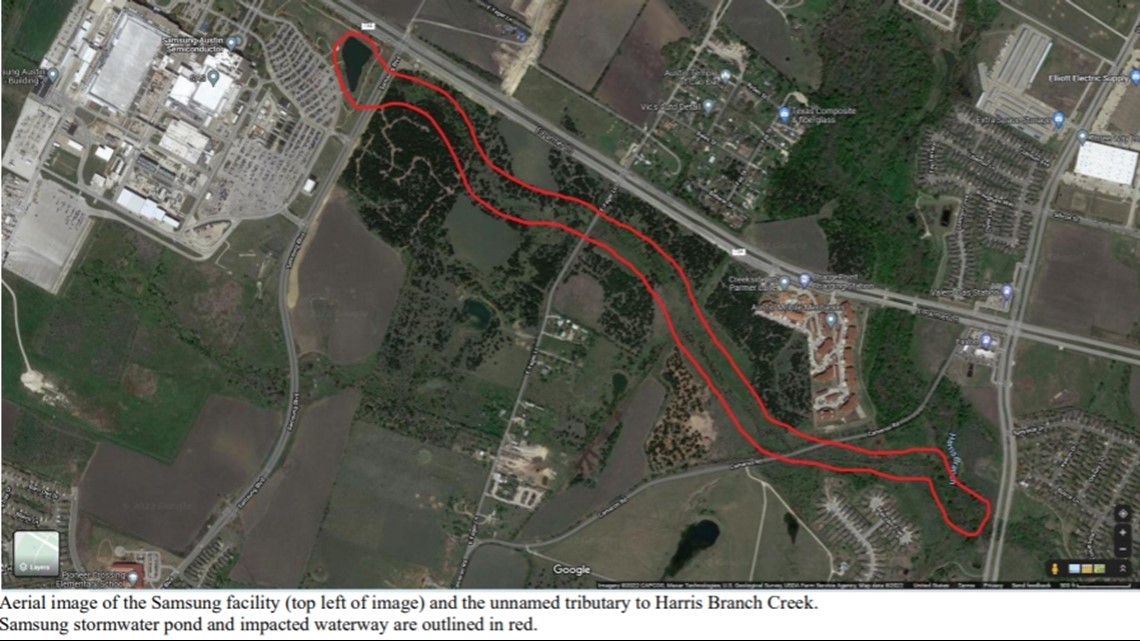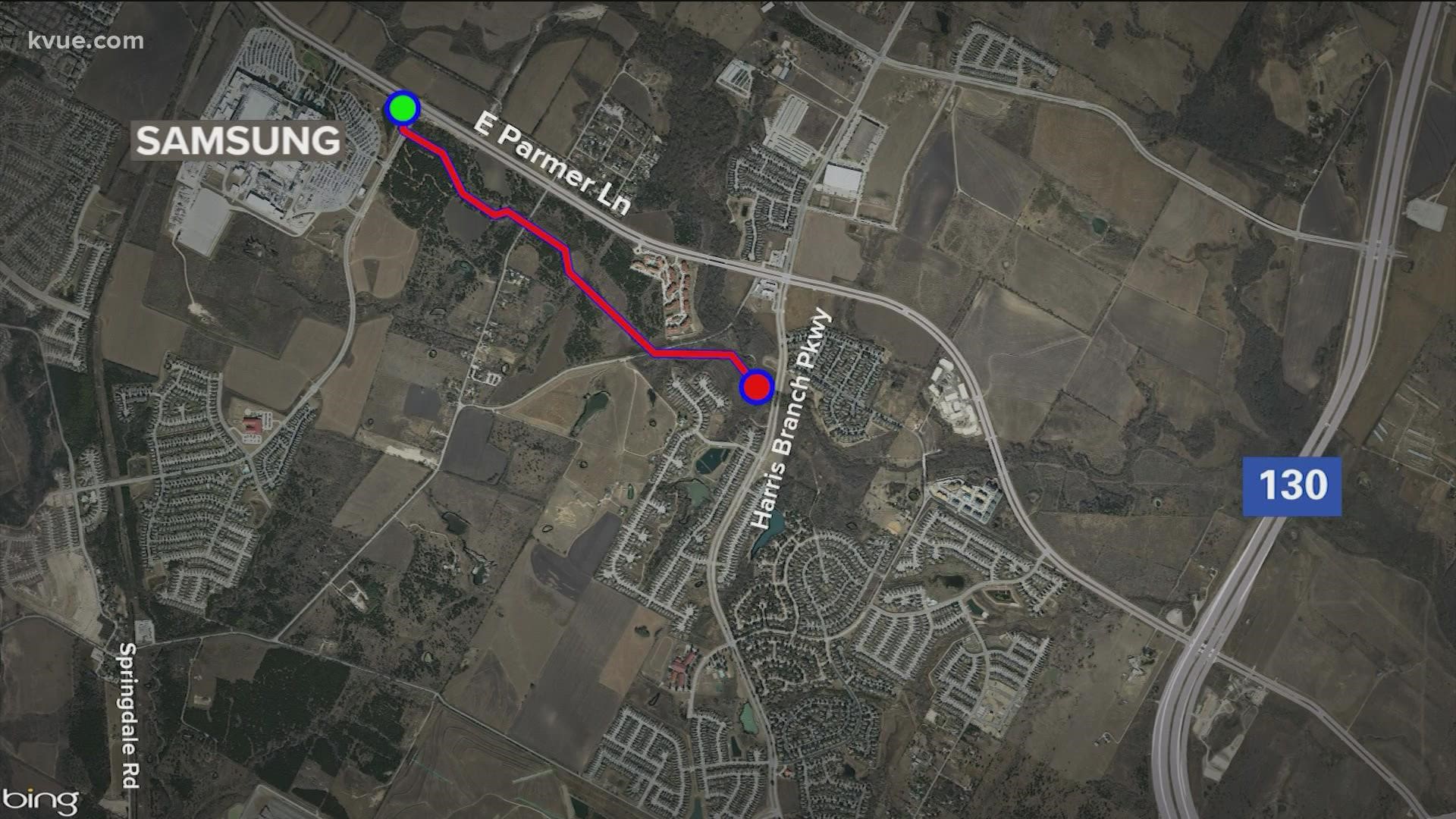AUSTIN, Texas — The Samsung facility in northwest Austin spilled up to 763,000 gallons of acidic waste into a tributary of Harris Branch Creek over a period as long as 106 days, according to a memorandum sent to the Austin City Council.
The memo sent by the Watershed Protection Department (WPD) to the council on Thursday claims sulfuric acid waste reached the storm water pond on the Samsung property and impacted the nearby tributary. However, Samsung issued a statement late Friday saying it was not sulfuric acid waste, although the discharge was acidic. An initial report by the Texas Commission on Environmental Quality (TCEQ) identified it as "diluted acidic wastewater," but did not mention anything regarding sulfuric acid.
WPD staff said they "found virtually no surviving aquatic life within the entire tributary," spanning from the Samsung property to the main part of Harris Branch Creek, near Harris Branch Parkway. Staff said the dead aquatic life indicated the spill had a "significant short-term impact" on the aquatic life and ecology, but that it's too early to know what the long-term impacts are.
The memo went on to state that no "measurable impacts" to water chemistry or aquatic life were found further downstream.
As for the impact on human health, the memo said it's letting the Texas Commission on Environmental Quality (TCEQ) report any assessments. So far, TCEQ has reported zero impacts on people. The memo mentioned that there is one apartment complex north of the tributary and a single-family housing neighborhood south of the tributary, both near Harris Branch Parkway.


Samsung notified the TCEQ and the National Response Center of the spill on Jan. 14 and the TCEQ informed the WPD days later on Jan. 18, per the memo. Samsung reportedly later said that sections of the tributary had a pH of between 3 and 4, which the memo said is "far below normal for surface water."
Spill investigators with the WPD met with Samsung staff on Jan. 18 and Jan. 19 and were told that the discharge had stopped, the memo states. Investigators surveyed the scene and noticed iron staining within the channel, which is consistent with a low pH environment, beginning at the storm water pond on the property and down the tributary to the meeting point with Harris Branch Creek. That's about 1.5 miles.
The survey on Jan. 19 by investigators found that the pH had returned to "close to normal levels." At the main branch of the creek, investigators found healthy aquatic life and no iron staining, indicating that no pH drop had happened. According to TCEQ, Samsung had addressed the issue by putting sodium bicarbonate (baking soda) into the tributary to counteract the acidity. The tech company also used lime treatment to neutralize the acidity in the stormwater pond.
The department said it is receiving daily updates from Samsung on cleanup efforts and that the WPD will inspect the pond once the remediation is complete. The department said in the memo it will also conduct weekly surveys of the water.
The TCEQ is the lead agency on the incident and is overseeing communications, investigation, cleanup and enforcement, per the memo.
Samsung Austin Semiconductor sent KVUE the following statement Friday morning:
"Samsung Austin Semiconductor is committed to environmental stewardship and recognizes our role in preserving the natural beauty of Central Texas.
"On Jan. 14, we discovered a release of industrial wastewater that entered our stormwater collection pond. A majority of the wastewater was contained on-site; however, a portion was inadvertently released into an unnamed small tributary that is upstream of Harris Branch Creek. We immediately stopped the release, retained a leading environmental engineering company as a partner and took action to implement a solution to minimize impact to the environment and restore the tributary.
"The ecological impact was a temporary lowering of pH levels in the tributary only – none in the creek. The water within the tributary has already returned to normal conditions. Harris Branch Creek is confirmed to be unaffected.
"Appropriate agencies were notified and we are fully cooperating with all of them."
When that release was discovered on Jan. 14, Samsung said it took immediate action to stop it and remediate impacted areas. The cause was said to be an undetected equipment failure inside one of its buildings that allowed the wastewater to flow into the site's storm water system. The company has since improved monitoring systems and is implementing "strong countermeasures to ensure this does not happen again."
"In alignment with our core value of environmental stewardship, we are committed, and already taking action, to fully restore the health of the tributary," a spokesperson said.
TCEQ's full initial statement is below.
TCEQ is currently conducting an investigation of the discharge. Below is a brief overview of the typical phases of action that can occur if/when environmental violations under the TCEQ’s jurisdiction are found. For more details please see the following link: The Enforcement Process: From Violations to Actions - Texas Commission on Environmental Quality - www.tceq.texas.gov.
On January 14, 2022, Samsung notified TCEQ Austin Region of a discharge of approximately 763,000 gallons of diluted acidic (low pH) wastewater from the facility located at 12100 Samsung Blvd, Austin, TX. The initial notification indicated the discharge was found during unrelated construction activities and occurred over time. It was reported that the discharge was due to a leak in a sump underneath a subfloor allowing the acidic wastewater to flow to the on-site stormwater pond and then to an offsite tributary of Harris Branch. The discharge was stopped after discovery, repairs made to the pipe, and actions were taken to stop any additional discharge from the on-site pond.
Subsequent assessments by Samsung determined the discharge impacted the stormwater pond and the tributary to Harris Branch up to the confluence of Harris Branch. The initial impacts included low pH and orange discoloration within areas of the tributary. Samsung has conducted daily sampling in the tributary and applied sodium bicarbonate (baking soda) to increase the pH levels. On January 24th the sodium bicarbonate treatment was removed, and sample results have shown pH levels within expected neutral ranges. Tributary sampling is still being conducted to ensure there are no changes in pH levels.
Concurrently, Samsung also initiated lime treatment of the low pH water contained in the on-site stormwater pond. Once treatment is complete, and the pH levels within the pond are within neutral ranges, the water will be routed to their on-site industrial waste treatment unit and then discharged to the City of Austin’s wastewater system.
TCEQ’s Austin Region, as well as City of Austin Watershed Protection staff, have been on-site to evaluate the discharge and on-going treatment actions. Our Austin Region has initiated an investigation and will continue to work with facility representatives until all corrective actions are complete.
Since the initial notification, Samsung has provided daily status updates to TCEQ Austin Region and the City of Austin and will continue to do so until all corrective actions are complete.
We have not documented any impacts to human life as a result of the discharge.
PEOPLE ARE ALSO READING:

